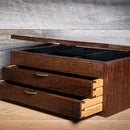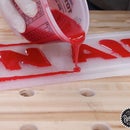Introduction: DIY Rustic Farmhouse Dining Table
VIDEO TUTORIAL ON RUSTIC RECLAIMED DINING TABLE WITH CURVED PEDESTAL BASE
I'm back with another Farmhouse style dining table. Except this time i change it up, and instead of the standard "X" or "H" style, I add some curves to the base.
Recomended Tools
Step 1: Top Glue Up : Mill Stock
Choose your wood. If using reclaimed remove all of the nails, if you cannot remove them hit them below the face of the wood.
Step 2: Top Glue Up : Glue Up and Flatten
Glue up top in thirds. After drying relief cut the bottom if there is still any twice. Use a planer sled to flatten bottom of 3 sections. Glue up whole top. Then once dry cut the table to size.
Step 3: The Base : Cut Lumber Down to Rough Size
Mill down stock for base, rough cut, joint, plane, and saw to size.
Step 4: The Base : Glue Up Pedestal Parts
Glue up parts for the pedestal. Let dry, then flatten and square with the jointer, planer, and mitre saw.
Step 5: The Base : Joinery and Curves
Mark the curves on the blanks for the pedestal. Layout joinery for the mortises, and cut with domino or dowel. Then proceed to cut the curves on the bandsaw. Smooth on oscillating spindle sander and with hand sander. Glue up using the cutoffs from the bandsaw.
Step 6: The Base :Assembling the Feet
Measure out lap joints on table feet. Cut on mitre saw or with table saw. Join crosses with glue and screws. Mark out and cut chamfer on feet.
Step 7: The Base : Joinery
Joint and glue up sub base. Layout and cut joinery for posts. Pre- drill and countersink for curves joinery. Join with 3" screws
Step 8: Final Sanding and Finish
Sand top and fill any voids with epoxy. Sand dried epoxy and then finish with favorite finish. Attach your top and you're done!

Participated in the
Home Improvement Contest 2017











